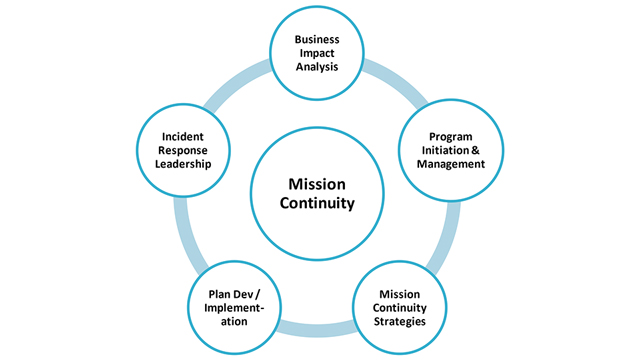- Home
- About JCCC
- Leadership & Governance
- Administration
- Mission Continuity
The Office of Mission Continuity and Risk Management helps JCCC continue its mission during disruption or disaster.
The Office of Mission Continuity helps JCCC continue its mission during a disruption or disaster, sustaining instruction and administration functions despite adversity. Mission continuity topics can be wide ranging and include the following:
- Public health emergency
- Air quality
- Human error
- Loss of internet or utilities
- Media or reputation risk
- Succession planning
- Weather delays and closures
The Mission Continuity team provides five core services to the College:
Business Impact Analysis
Identify and prioritize the entity's functions and processes to ascertain which ones will have the greatest impact should they not be available (3-year cycle).
Program Initiation and Management
Introduce key concepts, such as program management, risk awareness, identification of critical functions/processes, recovery strategies, training and awareness, and exercising/testing.
Plan Development and Implementation
Document plans (Department Plans, Disaster Recovery Plans and Master Mission Continuity Plan) to be used during an incident that will enable the College to continue to function (Annual cycle).
Risk Assessment Leadership
Identify top risks that can adversely affect College mission or resources. Establish Risk Owners to identify individuals/areas responsible for managing each type of risk, as well as mitigation activities and early risk indicators (year-round process).
Mission Continuity Strategies
Select cost-effective strategies to reduce deficiencies as identified during the risk assessment and business impact analysis processes.

Mission continuity requires collaboration and partnership across the College. All staff have a role in ensuring the College’s mission is accomplished despite circumstances.
It starts with each department conducting a BIA every three years. BIAs feed into a Department Continuity Plan (DCP) which demonstrates how long a department could be without service and on what applications it depends. Both the BIA and DCP feed into the College’s overall disaster recovery plan, which lays out steps to minimize mission and business disruption.
About JCCC
- Accreditation
- Our Campus
- Center for Sustainability
- Our Story
-
Leadership & Governance
- Academic Master Plan
-
Administration
- President
- Access Control Office
- Accounts Payable
- Audit
- Bursar's Office
- Campus Services
- Custodial Services
- Educational Technology Center
- Facility Planning
- Finance and Auxiliary Services
- Grants
- Human Resources
- Office of Inclusion & Belonging
- Information Services
- Institutional Effectiveness
- Interior Services
- Printing Services
- Mission Continuity
- Maintenance & Grounds
- Marketing Communications
- Postal Services
- Procurement Services
- Staff & Organizational Development
- Student Success and Engagement
- Transportation Department
- Video Services
- Warehouse
- Advisory Committees
- Board of Trustees
- Copyright
- Faculty
- Giving to JCCC
- Policies & Procedures
- Reports
- Strategic Plan
- Contact JCCC
- JCCC Foundation
- Reach Your Goals
- Faculty Degree Information
- JCCC: A Smart, Affordable College Choice
